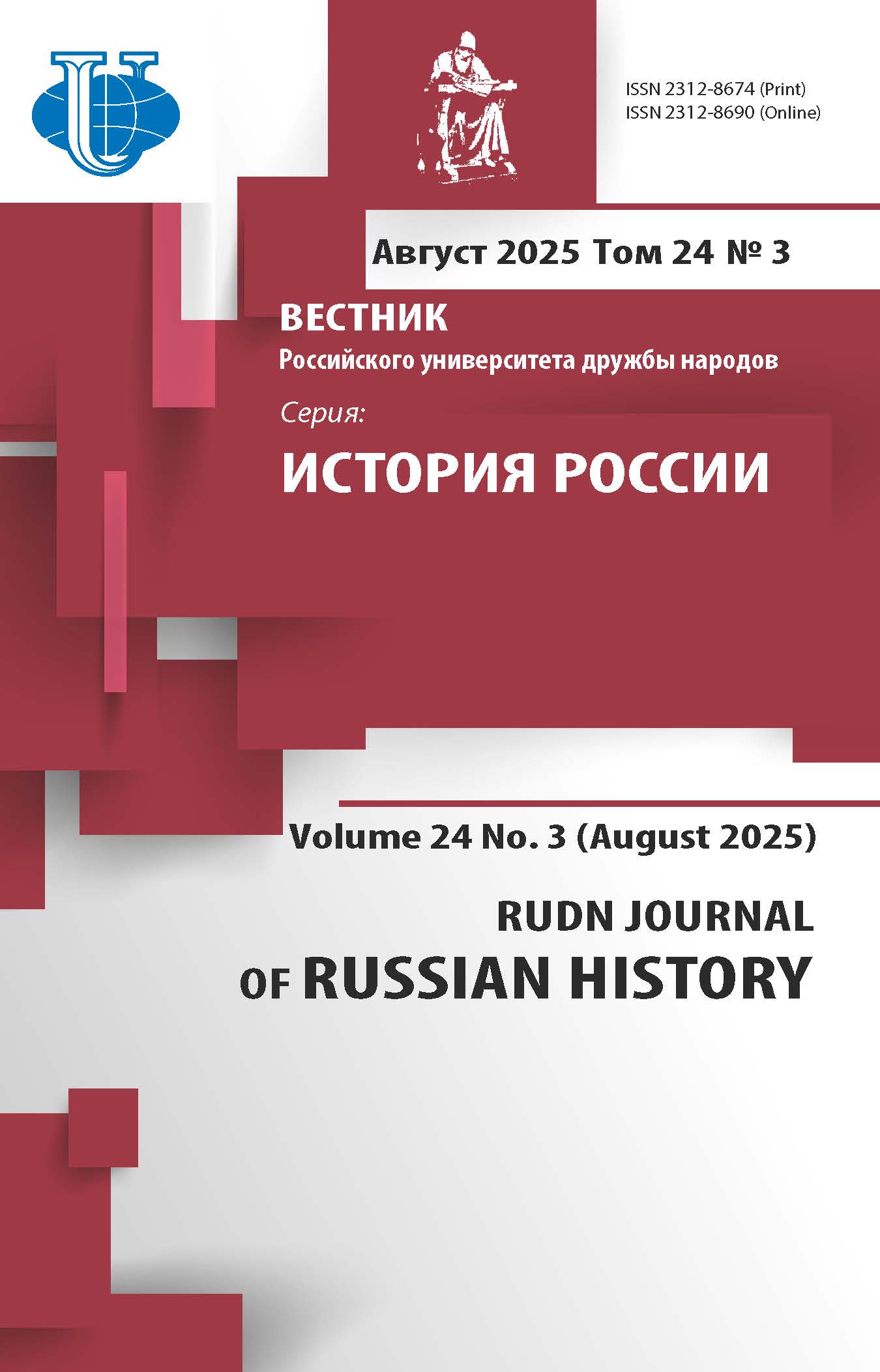ЕВРОПЕЙСКИЕ ЕВРЕИ В РУССКОМ ТУРКЕСТАНЕ НА РУБЕЖЕ ХIХ-ХХ ВВ
- Авторы: Гитлин С.И.1
-
Учреждения:
- Неаффилированный автор
- Выпуск: Том 17, № 2 (2018): ЕВРЕИ В РОССИИ
- Страницы: 296-319
- Раздел: ЕВРЕИ В РОССИИ
- URL: https://journals.rudn.ru/russian-history/article/view/19104
- DOI: https://doi.org/10.22363/2312-8674-2018-17-2-296-319
- ID: 19104
Цитировать
Полный текст
Аннотация
Статья посвящена важной научной проблеме адаптации евреев в Туркестане. Ее осмысление дает возможность на конкретном примере увидеть взаимодействие представителей двух основных религий в России - христианской и мусульманской. Актуальность данной темы определяется также сохраняющимся противостоянием Израиля и арабского мира, евреев и мусульман. Переселение евреев в период колонизации Средней Азии позволяет также понять противоречия национальной и связанной с ней миграционной политики царской России на рубеже ХIХ-ХХ вв. Автор с помощью разнообразного круга источников раскрывает особенности жизни евреев в Российской империи, различные стороны которой длительное время замалчивались или искажались в советской историографии. В статье приводятся данные по локализации, численности и социальному составу еврейского населения на территории Российской империи. Отмечается, что подавляющее большинство первых европейских евреев составляли бывшие военнослужащие - рядовые и унтер-офицеры. Евреи-ашкеназы сыграли важную роль в строительстве железных дорог в России, и прежде всего Ташкентско-Оренбургской дороги. Автор заключает, что строительство железных дорог в Европе также было важным полем деятельности еврейских банкиров. В этой области большую роль играли личные связи еврейских капиталистов с правительствами, так как железные дороги прокладывались большей частью на основании специальных концессий и под официальным контролем. В работе показано, что евреи Средней Азии работали нередко в качестве подрядчиков, врачей, юристов. За сравнительно короткий исторический период евреи продемонстрировали свою высокую социальную активность и внесли немалый вклад в развитие территории Средней Азии.
Ключевые слова
Об авторах
Семен Исаакович Гитлин
Неаффилированный автор
Автор, ответственный за переписку.
Email: gitlinsimon@hotmail.com
Список литературы
- Азиатская Россия // Люди и порядки за Уралом. Т. 1. СПб.: Издание переселенческого управления Главного управления землеустройства и земледелия. 1914. С. 31-38
- Вамбери Арминий (Герман). Путешествие по Средней Азии из Тегерана через Туркменскую пустыню по восточному берегу Каспийского моря в Хиву, Бухару и Самарканд. СПб., 1865
- Галузо П.Г. Туркестан-колония. М., 1929
- Замятин Д.Н. Русские в Центральной Азии во второй половине XIX века: стратегии репрезентации и интерпретации историко-географических образов границ // Восток. М., 2002. № 1. С. 45-59
- Кунавина Г.С. Формирование железнодорожного пролетариата в Туркестане (1881-1914 гг.). Ташкент, 1967. С. 21.
- Махмудов М. Доктор Слоним // Ташкентская правда. 28 сентября 1990.
- Рабич Р. Российские евреи в дореволюционном Туркестане (Правовое и социальное положение, 1864-1914 гг.) // Евреи в Средней Азии: прошлое и настоящее. Экспедиции, исследования, публикации. Сб. науч. трудов. Составитель: И.С. Дворкин. Ответ. ред. Т.Д. Вишневская. СПб., 1995. С. 133
- Терентьев М.А. История завоевания Средней Азии. В 3-х тт. СПб., 1903-1906
- Туркестанские ведомости. 14 августа 1905
- Туркестанские ведомости. 18 января 1905
- Туркестанские ведомости. 4 (17) октября 1912
- Узбекистан в сообщениях путешественников и ученых (20-80-е годы ХIХ в.) / Составитель Б.В. Лунин. Ташкент, 1990
- Центральный государственный архив республики Узбекистан (ЦГА РУз.). Ф. 1. Оп. 29. Д. 20. Л. 8
- Эттингер Ш. История еврейского народа. Ч. 5 / Пер. с иврита. Тель-Авив, 1967. С. 480.
- ЦГА РУз. Ф. 1. Оп. 11. Д. 1608. Л. 22, 23 об
- ЦГА РУз. Ф. 1. Оп. 11. Д. 1608. Л. 61-61об
- ЦГА РУз. Ф. 1. Оп. 12. Д. 1133. Л. 23-24, 24 об., 34-35 об
- ЦГА РУз. Ф. 1. Оп. 13. Д. 554. Л. 197 об. - 198.
- ЦГА РУз. Ф. 1. Оп. 17. Д. 848. Л. 109-121.
- ЦГА РУз. Ф. 1. Оп. 2. Д. 1033. Л. 57 об
- ЦГА РУз. Ф. 1. Оп. 20. Д. 5429. Л. 2
- ЦГА РУз. Ф. 1. Оп. 20. Д. 7689. Л. 2.
- ЦГА РУз. Ф. 1. Оп. 31. Д. 813. Л. 2-3, 14-16
- ЦГА РУз. Ф. 1. Оп. 4. Д. 152. Л. 3-3 об
- ЦГА РУз. Ф. 1. Оп. 4. Д. 1640. Л. 5-10
- ЦГА РУз. Ф. 1. Оп. 4. Д. 1664. Л. 162
- ЦГА РУз. Ф. 1. Оп. 4. Д. 1664. Л. 246-248.
- ЦГА РУз. Ф. 1. Оп. 4. Д. 224. Л. 5, 21
- ЦГА РУз. Ф. 461. Оп. 1. Д. 2149. Л. 2
- ЦГА РУз. Ф. 461. Оп. 1. Д. 282. Л. 36.
- ЦГА РУз. Ф. И-40. Оп. 1. Д. 517. Л. 30
- ЦГА РУз. Ф.1. Оп. 17. Д. 848. Л. 109-121
- ЦГА УРУз. Оп. 4. Д. 874. Л. 24-24 об., 25, 68-68 об
Дополнительные файлы














